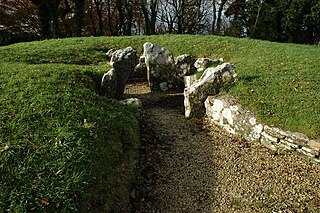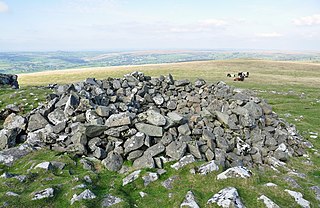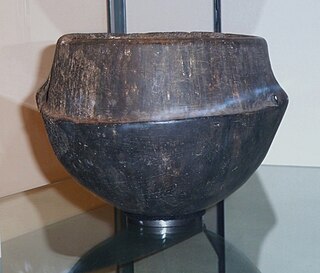Related Research Articles

In engineering, a foundation is the element of a structure which connects it to the ground or more rarely, water, transferring loads from the structure to the ground. Foundations are generally considered either shallow or deep. Foundation engineering is the application of soil mechanics and rock mechanics in the design of foundation elements of structures.

Oldbury Camp is the largest Iron Age hill fort in south-eastern England. It was built in the 1st century BC by Celtic British tribes on a hilltop west of Ightham, Kent, in a strategic location overlooking routes through the Kentish Weald. The fort comprises a bank and ditch enclosing an area of about 50 hectares, with entrances at the north-east and south ends. Wooden gates barred the entrances. Archaeological excavations carried out in the 1930s and 1980s found that the hill fort's interior had probably not been permanently occupied. It had been abandoned around 50 BC and the north-east gate had been burned down, possibly due to a Roman invasion. The wooded southern part of Oldbury Camp is now owned and managed by the National Trust and is open to the public.
In archaeology, a ring ditch is a trench of circular or penannular plan, cut into bedrock. They are usually identified through aerial photography either as soil marks or cropmarks. When excavated, ring ditches are usually found to be the ploughed‐out remains of a round barrow where the barrow mound has completely disappeared, leaving only the infilled former quarry ditch. Both Neolithic and Bronze Age ring ditches have been discovered.

A breastwork is a temporary fortification, often an earthwork thrown up to breast or shoulder height to provide protection to defenders firing over it from a standing position. A more permanent structure, normally in stone, would be described as a parapet or the battlement of a castle wall.
A tree throw or tree hole is a bowl-shaped cavity or depression created in the subsoil by a tree.

The Cortaillod culture is one of several archaeologically defined cultures belonging to the Neolithic period of Switzerland. The Cortaillod Culture in the west of the region is contemporary with the Pfyn Culture in the east and dates from between 3900-3500 BC. The Classic Cortaillod culture of the western Alpine foreland and the Early Cortaillod culture of central Switzerland pre-date this at 4300-3900 BC.

Figsbury Ring is an 11.2 hectare biological Site of Special Scientific Interest in Wiltshire, England, notified in 1975. It is owned and managed by the National Trust.

In archaeology, earthworks are artificial changes in land level, typically made from piles of artificially placed or sculpted rocks and soil. Earthworks can themselves be archaeological features, or they can show features beneath the surface.

A ringwork is a form of fortified defensive structure, usually circular or oval in shape. Ringworks are essentially motte-and-bailey castles without the motte. Defences were usually earthworks in the form of a ditch and bank surrounding the site.
Timothy Darvill OBE is an English archaeologist and author, best known for his publications on prehistoric Britain and his excavations in England, Wales, and the Isle of Man. He is Professor of Archaeology in the Faculty of Science and Technology Bournemouth University in England. In April 2008 he co-directed excavations within Stonehenge, together with Professor Geoffrey Wainwright and Dr Miles Russell, to examine the early stone structures on the site. The work featured heavily in a BBC Timewatch programme which examined the theory that Stonehenge was a prehistoric centre of healing. He was appointed OBE in the 2010 Queen's Birthday Honours.

51.71025°N 2.29970°W

The Pipers are a pair of standing stones near The Hurlers stone circles, located on Bodmin Moor near the village of Minions, Cornwall, UK. They share the name with another pair of standing stones near the Merry Maidens to the south of the village of St Buryan, also in Cornwall.
Iraq ed-Dubb, or the Cave of the Bear, is an early Neolithic archeological site 7 km (4.3 mi) northwest of Ajlun in the Jordan Valley, in modern-day Jordan. The settlement existed before 8,000 BCE and experimented with the cultivation of founder crops, side by side with the harvesting of wild cereals. Along with Tell Aswad in Syria, the site shows the earliest reference to domestic hulled barley between 10,000 and 8,800 BCE. The site is located on a forested limestone escarpment above the Wadi el-Yabis in northwest Jordan. An oval-shaped stone structure was excavated along with two burials and a variety of animal and plant remains.

A tor cairn is a prehistoric cult site occurring in the British Isles, especially in Cornwall and Devon but also in Wales. It consists of a circular enclosure of stones or a platform of loose rocks surrounding a natural tor, sometimes encircled by a ditch. The diameter of the roughly 35 tor cairns ranges from 12 to over 30 metres and their height varies from 0.5 to 4.0 metres. There is usually an entrance to the enclosed area and pits in the ground between the rock outcrop (tor) itself and the enclosure.

In archaeology, a hut circle is a circular or oval depression in the ground which may or may not have a low stone wall around it that used to be the foundation of a round house. The superstructure of such a house would have been made of timber and thatch. They are numerous in parts of upland Britain and most date to around the 2nd century BC.

A burgus or turris ("tower") is a small, tower-like fort of the Late Antiquity, which was sometimes protected by an outwork and surrounding ditches. Darvill defines it as "a small fortified position or watch-tower usually controlling a main routeway."
This page is a glossary of archaeology, the study of the human past from material remains.
Beacharra ware, also known as Ballyalton bowls, is a style of Middle Neolithic pottery, defined by Thomas Hastie Bryce (1862–1946), which is only found in the western parts of Scotland, including Kintyre). The comparable pottery style in Ireland is known as Western Neolithic ware. British archaeologist, Stuart Piggott divided Beacharra ware into 3 groups:

Western Neolithic ware, also known as Western style Neolithic pottery or New Stone Age pottery in the Western-style, is a type of pottery of the Early and Middle New Stone Age, which is found in the western parts of the British Isles and especially in Ireland. It was defined in 1961 by Humphrey Case (1918–2009). He described the pottery as usually round-bottomed bowls, which were normally smooth, thin-walled and hard, usually dark brown and sometimes with a profile at the shoulder or area of the mouth.
Abingdon ware is a Middle Neolithic, decorated, round-bottomed pottery found in an ancient causewayed enclosure at Abingdon-on-Thames, whence the name, about 15 kilometres south of Oxford, as well as in the upper Thames valley and central England.
References
- ↑ Darvill 2008, p. 57.